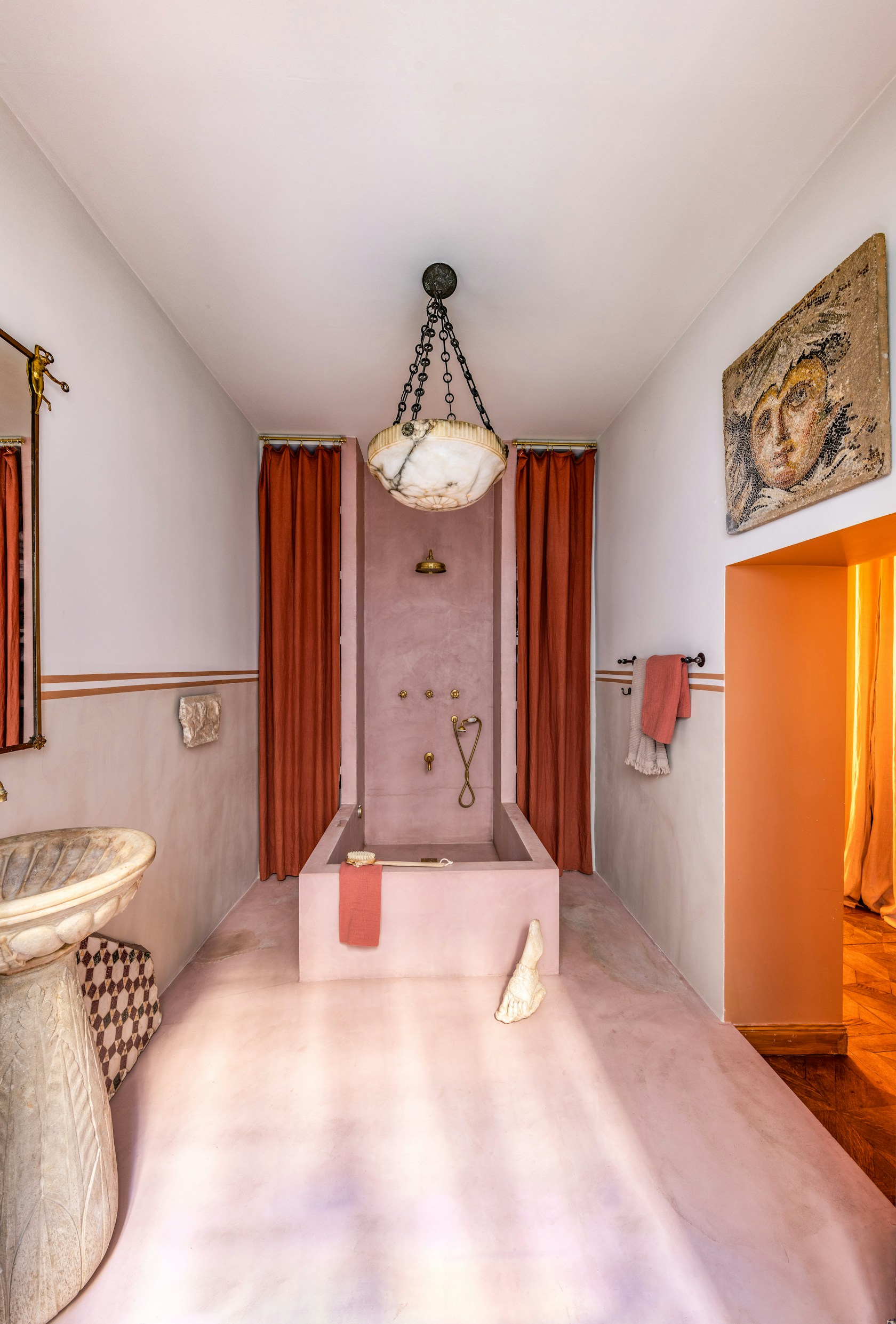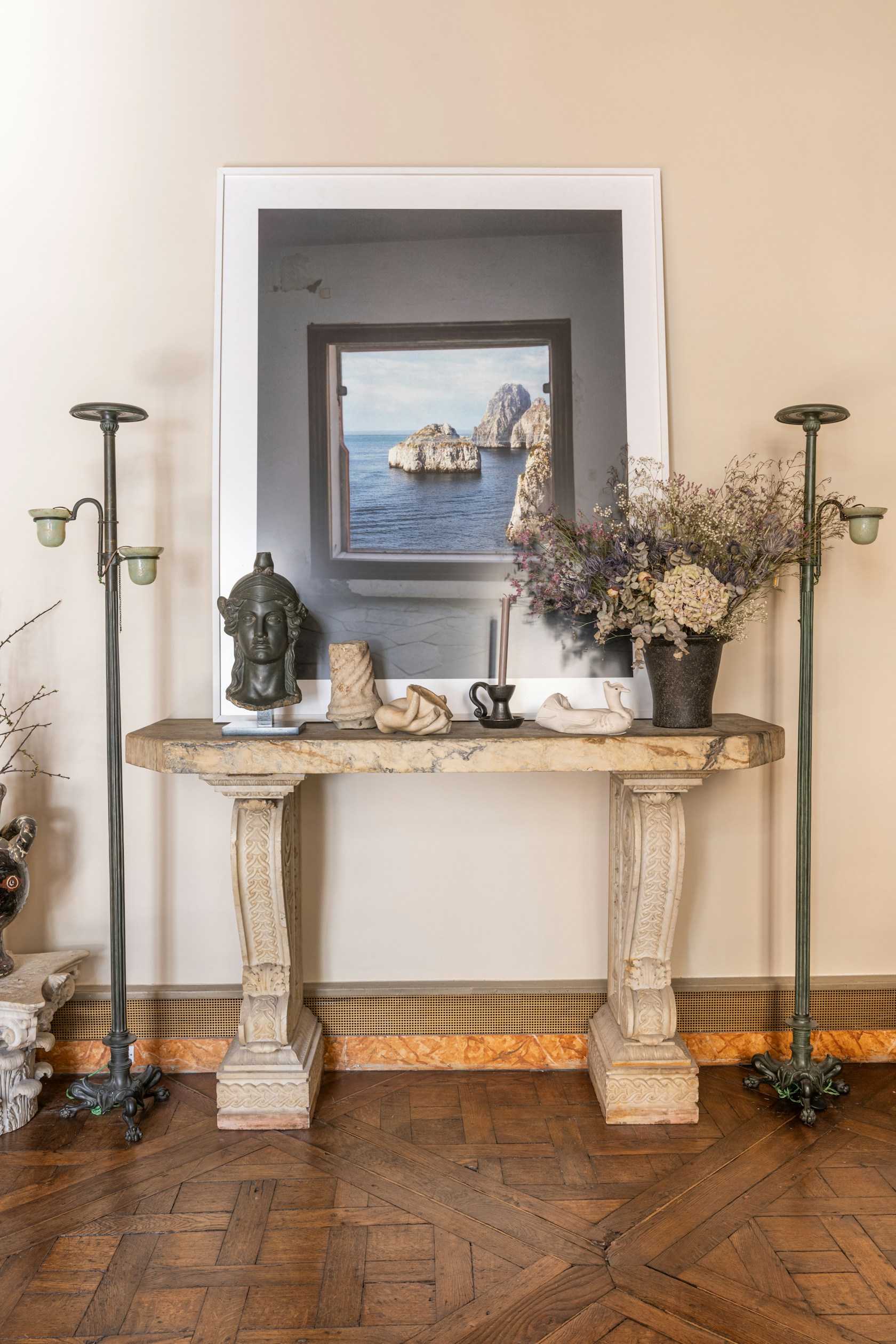
Step Into the Eclectic Home of Antique Dealers Ollivier and Gladys Chenel
As a family with deep roots in the art world, the Chenels share how they now live with art, antiques, and design in their Paris home
- By TEFAF Editors
- Living With Art
The Chenel family have been antique dealers for three generations. Originally from Nice, brothers Adrien and Ollivier, and Gladys, Ollivier’s wife, co-founded the Paris-based Galerie Chenel 21 years ago. Theophile, Ollivier and Gladys’ eighteen-year-old son, will soon join the business and bring in a fresh perspective. Here, Ollivier and Gladys invite TEFAF into their family home, and Gladys reflects on what inspires their personal collection, mixing artworks from various periods and fields, and the stories behind some of the works they have collected over the years.

The second living room, featuring a torso of goddess Hathor sculpted in granodiorite (Egyptian, New Kingdom, 18th dynasty, circa 1550–1292 BC) next to the sofa.
Did you and your family always want to pursue a career in the art world?
Ollivier always wanted to follow his dad and become an antique dealer, and our son has the same ambition. Adrien wanted to become a photographer; I always wanted to do something creative. We are all passionate about what we do and will never walk away from the art world.
What inspires you when collecting art?
We built our collection over many years, slowly. Many things inspire us; our eyes are always wide open. Mostly, we love Italy: Roman art of course, the Renaissance and Baroque periods, Italian collections displayed in palazzos, or the magic of a fragment that can instantly make you travel back in time. But we love to mix things as a reflection of our time, and we are curious about every field. Design furniture that we find easy to live with could carry a Greek vase next to a Picasso ceramic, the latter a subject to which our family is very attached. When they were young, our children were fascinated by Egyptian art, and we started to collect Egyptian works 15 years ago. We also love photography, and we are very interested in artists from the South of France. Furthermore, we like natural curiosities such as narwhal tusk or beautiful corals. We have the great privilege to be able to collect and be surrounded by things we love. Each piece has its own story. Some were found by chance on a flea market, in a small auction house, or during one of our travels. Others come from a friend’s gallery or through a nice encounter, and some come from family.
How can mixing different artworks complement and highlight one another?
A ceramic gives marble a visual lightness. Antiques next to a modern piece give it an extra soul. We do not collect by thinking in a decorative way, but because everything was chosen by us, it goes together quite naturally. I think the relative beauty of a collection is really personal, as it’s always a unique combination.

The Chenel family’s second living room.

Gladys, Ollivier, and their son in the family’s second living room.
”We love to mix things as a reflection of our time, and we are curious about every field. Design furniture that we find easy to live with could carry a Greek vase next to a Picasso ceramic.“ — Gladys Chenel

The main living room, featuring a marble console, consisting of a Roman top (1st–2nd century AD) and 17th-century Italian pedestals, Culbuto armchairs and a Culbuto ottoman by Marc Held (Knoll Edition, 1967), and a gray bust depicting the god Bes on a wooden pedestal (Etruscan, 2nd–1st century BC).
Can you share one of your first memories of a piece you collected?
One of the first sculptures we collected was a large Egyptian bronze cat. It came from an old French collection from the early 20th century. The sculpture was filthy when we purchased it. The restoration process was long, but we discovered some chiseled scarabs and a wonderful necklace on its neck, which could not be seen before. We lived with the cat for several years, placed above our fireplace, but one day we sold it; that’s what dealers do when they get a client looking seriously for an object.
Is there a philosophy or a common thread in your personal collection?
The common thread is our taste and our curiosity. Ollivier and I have a rule: everything in our house has to be approved by both of us. Some objects come from our gallery, which we keep in our home for a certain time. It gives us the opportunity to appreciate the pieces for a while and do the research properly.
What should one look for in an artwork?
People should first look at the aesthetic of the works. If you intend to live with a sculpture, you truly have to react physically with it; it should evoke an emotion. Then, the object’s authenticity is important; that is why we chose to specialize in sculpture and make it our expertise. Last but not least, provenance is of utmost importance in our field. Nowadays, if you want to collect, you have to make that a priority.

"We do not collect by thinking in a decorative way, but because everything was chosen by us, it goes together quite naturally. I think the relative beauty of a collection is really personal, as it’s always a unique combination." — Gladys Chenel

The Chenel family home’s bathroom.
What pieces of your personal collection stand out to you and why?
One of the sculptures in our collection is an exquisite torso representing Venus—Aphrodite in Greek mythology—the goddess of love and beauty. As she was born from the foam of the sea, she is often depicted with some allusion to water. Here, she is entirely naked and preparing to bathe. Her arms were probably held in front of her privates in a gesture of modesty, as she is surprised at her ablutions by an indiscreet gaze. The iconography is inspired by the Aphrodite of Knidos, the renowned masterpiece sculpted by the Greek sculptor Praxiteles in the 4th century BC. It is the classical representation that simply shows the natural beauty and sensuality of a woman’s body. Artists at different times were inspired by it and still are nowadays. Collecting a Venus has always been like collecting an icon, a hint of refined taste and gracefulness.
Another sculpture is a magnificent granodiorite torso representing the goddess Hathor, the most important deity of the Egyptian pantheon, whose name means “cosmic domain of Horus.” Wife of Horus, Hathor was originally the goddess of the sky and Mother Goddess. She was also known as the goddess of love, music, and joy, presiding over dances and banquets. In Egyptian iconography, she was represented either as a cow or a woman with cow ears, with horns framing a solar disc. Our torso represents the goddess as a woman, and having it in our living room takes me straight to Egypt. The strong cult of Hathor depicted the goddess proudly and elegantly, with her stylish hair and imposing jewelry. Even as a fragment, it takes our imagination back to the time of the pharaohs. The sobriety of her dark stone fills the room with her presence and captures the daylight of the windows.
As I mentioned before, Picasso’s ceramics are an important part of the history of the Chenel family. Several decades ago, Alain and Chantal Chenel, Ollivier and Adrien’s parents, completely fell in love with the Vallauris works of Picasso. They started to collect and specialize their gallery in these works. As children, Adrien and Ollivier were always surrounded by those ceramics, so it is quite natural that we have been collecting them as well. A few years ago, we decided to introduce them in our gallery, displayed with our marbles. The combination of a fragile ceramic and a strong stone sculpture works really well. This bird particularly is a great example of how Picasso played with this medium, how he molded a simple vase into the shape of a bird. On the side, you can see the fingerprint of the master—it’s magical!

A marble console situated in the main living room, consisting of a Roman top (1st–2nd century AD) and 17th-century Italian pedestals, featuring a white ceramic Oiseau by Picasso (1953).
What does living with art mean to you?
Living with art and kids could seem a bit dangerous, but, over the years, nothing has ever been damaged. Of course there were no balls allowed inside, but we always let them play everywhere because we wanted them to be careful and respectful with the artworks. We did not want to make them feel as though they lived in a gallery. It’s a cozy family house above all! Sometimes, we host private dinners for clients and friends; they all enjoy being surrounded by the artworks. It is very inspiring how art can bring you joy and a good mood. We are very fortunate to be living this way.
Throughout the years of collecting, what have you learned?
The one thing we’ve learned by collecting and living with art is understanding more deeply and truly each artwork we have, which helps to improve a sense of what to look for. Living with art gives you time to observe things you did not notice at first sight. For example, different daylight brings out another side of a sculpture: The stone changes following the daylight, and, in a poetic way, one can observe new perspectives. In our field, objects are highly historically charged, and they have an authentic soul. It is always amazing to be able to look at a sculpture that belonged to and was worshipped by people living two thousand years ago, or a sculpture that was once owned by many different personalities. That will never cease to amaze us.





